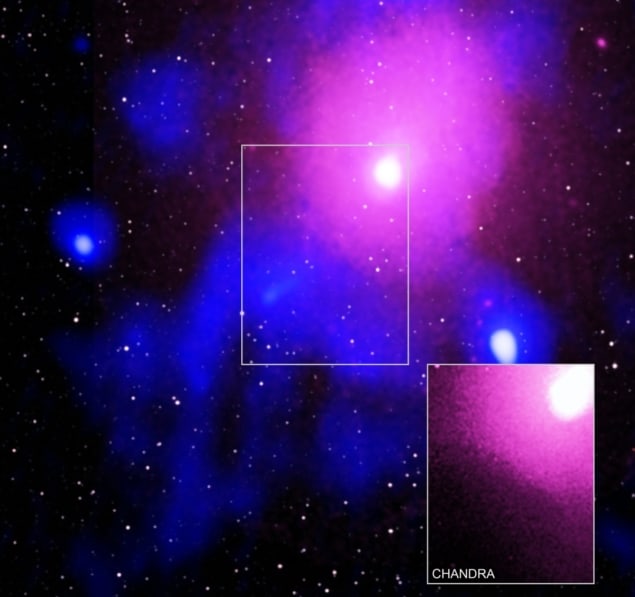
Evidence for the largest known explosion since the Big Bang has been reported by astronomers in the US and Australia. Using four telescopes, the team spotted a huge hole that the blast punched in the plasma that envelopes a galaxy cluster.
The researchers reckon that the hole was made by a colossal burst of energy from a supermassive black hole at the centre of one of the cluster’s galaxies. They estimate that the explosion involved the release of 5×1061 erg (5×1054 J) – which is the energy that 1020 Suns would output in a year. This is five-times more energy than the previous record holder for the biggest known explosion since the Big Bang.
The event occurred in the Ophiuchus galaxy cluster, which is 390 million light-years from Earth. Unlike the supernova explosion of a star, which occurs over a matter of months, the Ophiuchus event seems to have occurred over hundreds of millions of years.
Huge rift
Evidence for the explosion was observed using NASA’s Chandra X-ray Observatory, ESA’s XMM-Newton X-ray telescope, the Murchison Widefield Array radio telescope in Western Australia and the Giant Metrewave Radio Telescope in India. The multiple observations confirmed previous X-ray studies that suggested there was a huge rift in the cluster plasma. That X-ray evidence had been discounted because of the huge size of the structure. It was only when radio observations were made that astronomers became convinced of its existence.
“You could fit 15 Milky Way galaxies in a row into the crater this eruption punched into the cluster’s [plasma],” says Simona Giacintucci, from the Naval Research Laboratory in the US, who is one of six astronomers involved in the study.
Her colleague Melanie Johnston-Hollitt, from Curtin University adds “We’ve seen outbursts in the centres of galaxies before but this one is really, really massive…and we don’t know why it’s so big”.
The discovery was made using the first phase of the Murchison telescope, which had comprised 2048 antennas. The facility is being expanded to 4096 antennas, which Johnston-Hollitt says will make the telescope “ten times more sensitive”. As a result, she believes that many more such explosions will soon be discovered.
The explosion is described in the Astrophysical Journal.
https://news.google.com/__i/rss/rd/articles/CBMiV2h0dHBzOi8vcGh5c2ljc3dvcmxkLmNvbS9hL2JpZ2dlc3QtZXhwbG9zaW9uLXNpbmNlLXRoZS1iaWctYmFuZy1zcG90dGVkLWJ5LWFzdHJvbm9tZXJzL9IBAA?oc=5
2020-02-28 14:18:34Z
52780636055161
Bagikan Berita Ini














0 Response to "Biggest explosion since the Big Bang spotted by astronomers - physicsworld.com"
Post a Comment